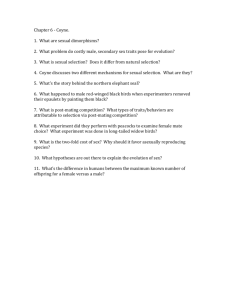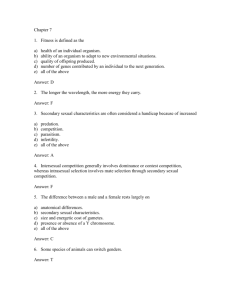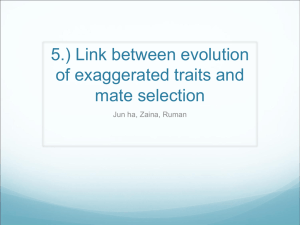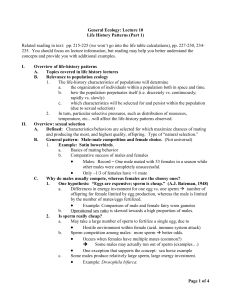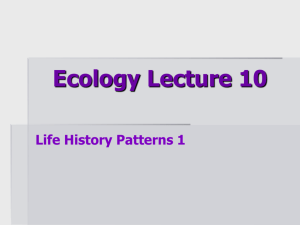General Ecology: Lecture 6
advertisement
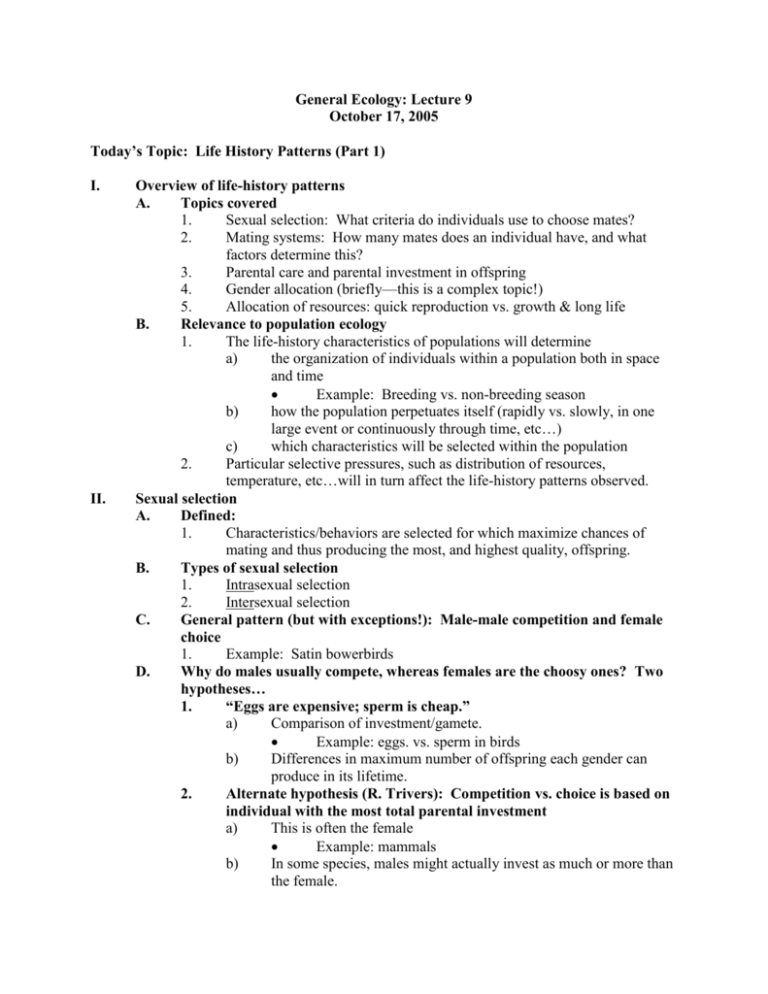
General Ecology: Lecture 9 October 17, 2005 Today’s Topic: Life History Patterns (Part 1) I. II. Overview of life-history patterns A. Topics covered 1. Sexual selection: What criteria do individuals use to choose mates? 2. Mating systems: How many mates does an individual have, and what factors determine this? 3. Parental care and parental investment in offspring 4. Gender allocation (briefly—this is a complex topic!) 5. Allocation of resources: quick reproduction vs. growth & long life B. Relevance to population ecology 1. The life-history characteristics of populations will determine a) the organization of individuals within a population both in space and time Example: Breeding vs. non-breeding season b) how the population perpetuates itself (rapidly vs. slowly, in one large event or continuously through time, etc…) c) which characteristics will be selected within the population 2. Particular selective pressures, such as distribution of resources, temperature, etc…will in turn affect the life-history patterns observed. Sexual selection A. Defined: 1. Characteristics/behaviors are selected for which maximize chances of mating and thus producing the most, and highest quality, offspring. B. Types of sexual selection 1. Intrasexual selection 2. Intersexual selection C. General pattern (but with exceptions!): Male-male competition and female choice 1. Example: Satin bowerbirds D. Why do males usually compete, whereas females are the choosy ones? Two hypotheses… 1. “Eggs are expensive; sperm is cheap.” a) Comparison of investment/gamete. Example: eggs. vs. sperm in birds b) Differences in maximum number of offspring each gender can produce in its lifetime. 2. Alternate hypothesis (R. Trivers): Competition vs. choice is based on individual with the most total parental investment a) This is often the female Example: mammals b) In some species, males might actually invest as much or more than the female. III. IV. What does Triver’s hypothesis predict for this situation? Example: pipefish Focus: Intrasexual selection: A. What types of traits, in a general sense, are selected for in intrasexual selection? B. Examples of traits resulting from intrasexual selection 1. Adaptations that help males successfully compete with other males to gain access to females a) Dominance behavior and large size/strength (i.e. elephant seals) b) Specialized weaponry such as antlers and horns used in competition c) Female mimicry/satellite behavior/sneakers (i.e. jack salmon) 2. Adaptations favoring the use of a male’s sperm a) Mate guarding: Example: Dungeness crab b) Mechanisms to displace or inactivate rival sperm Example: Dragonfly “scooper” penis c) Mechanisms to avoid sperm displacement Example: Anti-aphrodisiac of Heliconius erato (butterfly) d) Sexual interference Example: Spermatophore transfer interference in squid Focus: Intersexual selection: based on traits that develop due to mate choice A. Some criteria used by females 1. Material benefits a) Nutrition Example: nuptial gifts of some spiders and other insects Example: Female mantises devouring males while mating b) Anti-predator substances Defensive compounds in arctiid moths (i.e. tiger moths) 2. Ability of males to provide sufficient sperm a) Female fruit flies choose virgin males; males can actually deplete their sperm supply 3. Parental ability a) Can’t assess directly, but may be correlated with another aspect of male appearance or behavior Example 1: Epaulettes of redwing blackbird correlated with effort in nest defense, while his courtship effort is correlated with his feeding effort (honest signals of quality) 4. Genetic quality/health (difficult to separate) a) Example 1: song repertoire in great reed warblers Females picked male with larger song repertoires. This was correlated with greater survival of offspring (unrelated to parental care) b) Example 2: Bright coloration in many bird and fish Why might this be an important criterion? V. Origin/maintenance of mate choice preference for particular characteristics (especially ones that may seem excessive or exaggerated). A. The issue: In some species, why do males develop what appear to be extreme traits that actually can hamper their survival? 1. Example: A peacock’s is large and ungainly, as well as bright, making them much easier for predators to spot, and harder to escape from predators. a) Females choose the males with the largest tails and the most number of “eyespots” B. Hypothesis 1: Runaway selection (R.A. Fisher) 1. A type of directional selection: a) What starts as an “honest indicator” keeps becoming more extreme as females choose the males who best show that particular trait Example: peacock’s tail, explained by runaway selection C. Hypothesis 2: Handicap hypothesis (A. Zahavi) 1. Exaggerated trait reduces chance of survival, but shows the male has superior genes because he is able to survive despite the handicap a) Example: peacock’s tail, explained by the handicap hypothesis Any evidence to support this hypothesis? D. When does it stop? Study questions 1. Describe some population patterns that are influenced by life-history patterns. 2. What is sexual selection? How is it related to natural selection? 3. What is intrasexual selection? What is intersexual selection? 4. Why do males usually compete, whereas females usually are the choosy ones? Under what circumstances is the opposite true? Answer this question based on the two hypotheses addressed in lecture. 5. What types of traits, in a general sense, are selected for in intrasexual selection? 6. Describe several adaptations that enable males to successfully compete with other males. Also, be sure you are familiar with all examples presented in lecture. 7. List four key criteria females may use to select mates, and provide an example of each. Also, be sure you are familiar with all examples presented in lecture. 8. Describe the two hypotheses related to the origin and maintenance of mate choice preferences for exaggerated traits. Use the example of selection for a large, multi-eyed peacock tail to explain the differences between the two hypotheses. Is there any evidence that supports either hypothesis? 9. What limits how extreme a characteristic will become?





